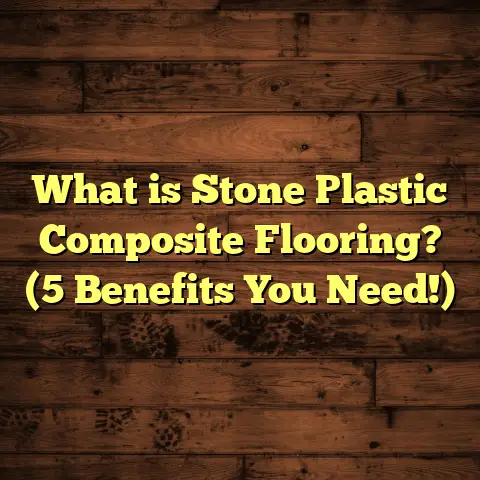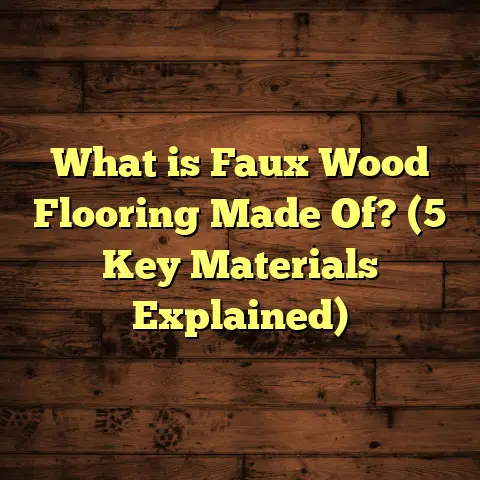What is the Best Bathroom Flooring? (5 Top Materials Revealed)
What is the Best Bathroom Flooring?
I have a story for you. Early on in my flooring career, I was called to fix a bathroom floor that had completely warped after just six months. The homeowner had chosen a beautiful hardwood floor without thinking about moisture issues. It was a tough lesson for both of us — bathrooms are unforgiving places for flooring if you pick the wrong material. Since then, I’ve become a bit of an expert in bathroom flooring options.
Bathrooms are unique spaces. You want floors that look great but can also handle water, humidity, and heavy foot traffic without slipping or staining. So what is the best bathroom flooring? Over the years, I’ve installed many types of floors in bathrooms, studied their performance, and learned what works and what doesn’t.
If you’re thinking about redoing your bathroom floor or building a new one, this article will help you understand your options. I’ll walk you through five of the best materials for bathroom floors, digging into technical details, real-world performance, costs, and maintenance. Along the way, I’ll share stories from my projects and tips to make your flooring last longer.
Let’s get started.
Understanding Bathroom Flooring Needs
Before we jump into materials, let’s talk about what makes bathroom flooring different from other rooms.
Why Bathroom Floors Are Such a Challenge
Bathrooms combine water, humidity, frequent spills, and constant foot traffic. Your floor has to withstand wet conditions without damage or becoming unsafe.
I’ve seen floors warp or bubble when moisture seeps underneath. Tiles crack if the subfloor isn’t stable. Slippery surfaces cause accidents. Mold and mildew grow in grout lines or under floors that aren’t properly sealed.
So your choice of material matters — it has to be water-resistant or waterproof, durable, slip-resistant, comfortable to walk on (especially in cold climates), and easy to keep clean.
Key Factors to Consider
Here’s what you should think about when choosing bathroom flooring:
- Water Resistance: Can the material handle standing water or high humidity without damage?
- Durability: Will it resist scratches, dents, and wear over time?
- Slip Resistance: How safe is it when wet? Does it have texture or coatings to prevent slips?
- Comfort: Is it cold or hard underfoot? Will you need rugs or mats for warmth?
- Maintenance: How much cleaning and upkeep does it require? Is sealing needed?
- Appearance: Does it fit your style? Can it mimic wood or stone if you want that look?
- Cost: What are the upfront and long-term costs including installation and maintenance?
My Experience With These Factors
I remember working with a client who wanted a gorgeous marble floor in her new bathroom. It looked stunning but was slippery when wet. We had to add anti-slip treatments later to prevent accidents. Another client loved the warmth of cork but didn’t realize it needed regular resealing to keep water out.
Every material comes with trade-offs. Knowing what matters most to you helps narrow down the choices.
Porcelain & Ceramic Tile: The Classic Choice
If I had to recommend one material for most bathrooms, tile would be it. Porcelain and ceramic tiles have been bathroom favorites for decades — and with good reason.
What Makes Tile So Popular?
Tile is nearly waterproof because it’s fired at high temperatures and glazed on top. Porcelain tiles are denser and less porous than ceramic ones, making them even better for wet areas.
I’ve installed tile floors in countless bathrooms ranging from small powder rooms to large master baths. They can handle splashes, spills, steam from showers, and even toilet leaks without damage.
Durability & Longevity
Tiles rarely scratch or dent, so they stay looking great over time. Some porcelain tiles can last 20+ years if installed correctly.
However, grout lines between tiles can absorb moisture if not sealed properly and may develop mold or mildew. That’s why I always recommend sealing grout and cleaning regularly.
Design Flexibility
Tiles come in thousands of styles — from glossy subway tiles to rough-textured stone looks. You can create patterns like herringbone or checkerboard or use large-format tiles for fewer grout lines.
One client wanted a classic black-and-white hexagonal mosaic; another went with wood-look porcelain planks that fooled even me at first glance.
Installation Tips
Tile installation requires a flat, stable subfloor and proper waterproofing underneath. Thin-set mortar must be applied evenly. Grout should be sealed after curing.
In one project, a bathroom with heated floors added a layer of thin-set over radiant heating mats before laying tile — the result was cozy underfoot and stylish.
Cost Breakdown
- Material: $3–$10 per square foot (porcelain tends to be pricier)
- Installation: $5–$15 per square foot depending on complexity
- Maintenance: Low cost; occasional grout sealing every 1–2 years
Using FloorTally helps me get accurate local labor rates and waste percentages factored into my estimates so clients know exactly what to expect financially.
Vinyl Flooring: Affordable & Waterproof
Vinyl has changed dramatically over the years. Luxury Vinyl Planks (LVP) and Tiles (LVT) now offer waterproof surfaces that look like wood or stone at a fraction of the cost.
How Vinyl Holds Up in Bathrooms
Vinyl is 100% waterproof, so there’s no risk of swelling like hardwood. It’s softer underfoot compared to tile and warmer too.
I installed luxury vinyl in a rental property bathroom where durability and ease of installation were essential. The tenant has been there three years now with no issues — no peeling edges or water damage.
Styles & Textures
You can get vinyl with textured surfaces that mimic wood grain or stone textures perfectly.
Some products even come with an attached underlayment for noise reduction and comfort.
Installation Advantages
Vinyl can be glued down or installed as floating floors with click-lock systems. This makes it faster and cheaper to install.
I’ve often used vinyl when clients want a quick bathroom makeover without tearing up subfloors.
Maintenance & Cleaning
Vinyl is stain-resistant and easy to clean with just soap and water. Avoid abrasive cleaners that can dull the finish.
Pricing Details
- Material: $2–$7 per square foot
- Installation: $1.50–$6 per square foot
- Durability: Average lifespan 10–20 years depending on quality
According to data from industry sources, vinyl flooring installations in bathrooms have risen by about 25% in recent years due to affordability combined with improved aesthetics.
Natural Stone: Timeless & Luxurious
Natural stone floors make a bold statement in bathrooms but come with special care requirements.
Beauty That Lasts
Marble, slate, granite, and travertine each bring unique textures and colors that no manufactured floor can match.
Clients often comment on how stone makes their bathrooms feel like spa retreats.
Challenges With Stone Floors
Stone is porous by nature — it absorbs water unless sealed properly. Without sealing, stains from soap scum or hair dye can become permanent problems.
It’s also harder underfoot than cork or vinyl and can feel cold unless paired with radiant heating systems.
Slip Resistance & Safety
Polished marble can be slippery when wet. Slate’s natural texture offers better grip but may be uneven.
Anti-slip sealers are available but add maintenance tasks down the line.
My Stone Experience
One homeowner I worked with wanted honed granite for low gloss but worried about stains. We applied multiple coats of penetrating sealer which kept the floor protected for over five years before resealing was needed.
Installation Complexity & Cost
Stone requires professional installation due to cutting precision needed for irregular shapes and ensuring level surfaces.
- Material cost: $5–$30 per sq ft
- Installation: $10–$25 per sq ft
- Maintenance: Regular resealing every 3–5 years recommended
Using FloorTally helps me break down these costs upfront so clients aren’t caught off guard by higher labor expenses related to stone cutting.
Engineered Hardwood: Real Wood Feel Without Full Risks
If you love hardwood but worry about water damage in bathrooms, engineered hardwood might be an option worth considering.
What Is Engineered Hardwood?
It’s made of layers — typically a plywood base topped with a thin hardwood veneer. This structure makes it more dimensionally stable than solid wood when exposed to moisture.
Bathroom Suitability
Engineered hardwood isn’t 100% waterproof but resists humidity better than solid wood. Spills should be wiped promptly though to avoid damage.
I helped a family install engineered oak planks in their powder room where splash risk was minimal — they’ve enjoyed hardwood warmth without major issues after three years.
Appearance & Feel
Because it’s real wood on top, you get authentic grain patterns and textures that vinyl or laminate can’t fully replicate.
It can be sanded and refinished once or twice depending on veneer thickness — though not as many times as solid wood floors.
Installation & Maintenance
Can be floated over waterproof underlayment or glued down for stability. Use water-resistant finishes as an extra layer of protection.
Keep humidity levels balanced using exhaust fans or dehumidifiers in bathrooms with engineered wood floors.
Cost Considerations
- Material: $4–$12 per sq ft
- Installation: $3–$8 per sq ft
- Maintenance: Moderate; avoid standing water; wipe spills immediately
FloorTally helps me compare engineered hardwood costs against other options quickly during project planning stages.
Cork Flooring: Soft & Sustainable Option
Not everyone thinks about cork for bathrooms but it offers some surprising benefits when sealed properly.
Why Choose Cork?
Cork flooring is made from harvested bark of cork oak trees — it’s renewable and eco-friendly. It feels soft and warm underfoot compared to tile or stone.
One client wanted an environmentally conscious bathroom remodel; we chose cork with multiple coats of water-resistant sealant. Four years later, the floor still looks great with minimal wear patterns.
Moisture Resistance & Care
Cork is naturally resistant to mold and mildew due to its cellular structure but requires sealing for full water protection.
Sealing every 2–3 years keeps moisture from penetrating and extends floor life significantly.
Comfort & Sound Absorption
Cork absorbs sound nicely — great if your bathroom is above living spaces. It also provides cushioning which helps reduce fatigue during long showers or grooming sessions.
Pricing Overview
- Material: $3–$8 per sq ft
- Installation: $4–$7 per sq ft
- Maintenance: Requires resealing every few years; gentle cleaning methods recommended
I use FloorTally frequently when budgeting cork projects because sealant costs need factoring alongside materials and labor for a complete picture.
Comparing Bathroom Flooring Materials: A Data-Driven Summary
Here’s a quick comparison table based on my experience combined with published data:
| Material | Water Resistance | Durability | Slip Resistance | Maintenance | Avg Material Cost ($/sq ft) | Installation Cost ($/sq ft) | Typical Lifespan (Years) |
|---|---|---|---|---|---|---|---|
| Porcelain Tile | Excellent | Very High | High (textured options) | Low (grout sealing) | 3 – 10 | 5 – 15 | 20+ |
| Luxury Vinyl | Excellent | High | Moderate | Low | 2 – 7 | 1.5 – 6 | 10 – 20 |
| Natural Stone | Moderate (sealing needed) | Very High | Varies (slippery if polished) | Moderate (resealing) | 5 – 30 | 10 – 25 | 20+ |
| Engineered Hardwood | Moderate | Moderate | Moderate | Moderate | 4 – 12 | 3 – 8 | 10 – 15 |
| Cork | Moderate (sealing needed) | Moderate | Good | Moderate (resealing) | 3 – 8 | 4 – 7 | 10+ |
This table helps me explain options clearly when clients are confused by all the choices out there.
Personal Tips for Bathroom Flooring Success
Over hundreds of projects, I’ve learned some practical tips that make a big difference:
- Always prioritize waterproofing underlayment especially for tile or hardwood.
- Use sealants on grout and porous materials right after installation.
- Pick slip-resistant finishes if you have kids or elderly at home.
- Keep cleaning simple but consistent; mold loves neglect.
- Factor in installation complexity when budgeting—intricate patterns cost more.
- Use tools like FloorTally early in planning to get realistic cost estimates including waste factors.
One time I skipped sealing grout on a rushed job; the client called back within months complaining about mildew buildup. Lesson learned: never skip steps even if you’re tight on time or budget!
FAQs About Bathroom Flooring
Q: Can I install hardwood in my bathroom?
A: Solid hardwood isn’t recommended due to moisture swelling risks. Engineered hardwood is better but still needs caution around water exposure.
Q: How do I keep tile grout clean?
A: Regular sealing plus cleaning with mild detergents prevents stains and mold growth effectively.
Q: Is vinyl flooring really waterproof?
A: Yes, vinyl planks and tiles are fully waterproof but seams must be tight to prevent water seepage underneath.
Q: How often do I need to reseal natural stone floors?
A: Typically every 3–5 years depending on traffic and product used.
Q: What’s the warmest flooring option?
A: Cork is naturally warm; engineered hardwood feels warmer than tile; radiant heating under tile adds warmth too.
Wrapping Up My Bathroom Flooring Advice
Choosing your bathroom floor isn’t just about looks — it’s about finding something that will stand up to daily life without headaches later on. I hope sharing my hands-on experience along with data-backed insights helps you make an informed choice that fits your style and budget perfectly.
If you want something long-lasting with low fuss, porcelain tile is hard to beat. For budget-friendly waterproof options that look great fast, vinyl shines. Natural stone offers luxury but demands care. Engineered hardwood brings warmth if you love wood textures but want some moisture resistance. Cork stands out if comfort and sustainability matter most.
Whenever I start planning new flooring projects now, I use FloorTally early on to calculate accurate cost estimates including materials, labor, waste factors, and local rates — it saves me time and surprises down the line. If you’re budgeting your own project, give tools like this a try; they make complex estimates simple!
What type of flooring are you leaning towards? Or maybe you want advice on installation techniques? Just ask—I’m here to help share everything I’ve learned through years working directly on these floors!





